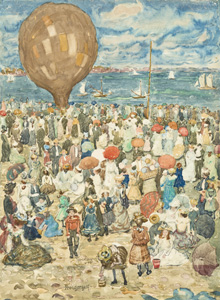
'The Balloon,' watercolor on paper by Maurice Prendergast, ca. 1901. |
In the opening pages of Moby-Dick Herman Melville devotes several paragraphs to the lure of the sea, as when the citizens of the "isle of the Manhattoes" stand around its borders "fixed in ocean reveries." He also notes the artist does the same thing when desiring to "paint you the most enchanting bit of landscape."
Making their selections for the show "Maurice Prendergast: By the Sea" at the Bowdoin College Museum of Art, curator Joachim Homann and Nancy Mowll Mathews, former curator at the Williams College Museum and a Prendergast specialist, had a thought similar to Melville's and chose works that Prendergast made of people at the shore. They followed this theme through nearly the whole of his body of work. It was a useful strategy that makes it easier to gather the threads of Prendergast's thinking over many years. By narrowing the scope of their choices they have added depth to our understanding of arc of the artist's working life. The exhibition is accompanied by a thorough catalog with essays by Homann and Mathews and others.
Maurice Brazil Prendergast (1858-1924) has been something of a problematic figure for those of us who grew up in the long shadow of modernism. His paintings, generally seen one or two at a time, could sometimes seem radical for their period and at other times mannered or whimsical, but he was always present as an artist who was part of the basic history of modern painting in America during what is sometimes called the Progressive era, from about 1890 to 1920. "By the Sea," concentrating as it does on one slice of his career over three decades or so, provides a much more nuanced and complex picture than I, for one, have carried as part of my mental historical furniture.
Prendergast was born in Newfoundland where his father operated a store. The family moved to Boston when the store failed, and Maurice and his brother Charles became commercial artists, doing advertising and lettering. They eventually went to Paris in 1891 to study art, and Maurice stayed there until 1895. Besides attending a couple of the more forward-looking schools of the day, he came to know Walter Sickert, Aubrey Beardsley, Édouard Vuillard, and Pierre Bonnard, and had seen shows of work by Van Gogh, Seurat, and Cézanne. In a return trip to France in 1907, he saw a large group of Cézannes at the Salon d'Automne, a landmark modernist event.
When he came back to Boston and started a professional career he had become what was, for that bastion of conservative tastes, a somewhat dangerous radical. While it is difficult today to see a work like "South Boston Pier" (1896) as the bleeding edge of pictorial innovation, the collection of colored shapes across the center creates, along with the curves of the wharf, a knowing tension between illusionistic and pictorial space. One feels the presence of the earlier Monet paintings with subject and color effects in competition. I suspect that by the time of "The Balloon" (1907), with its canvas-filling crowds, looming great balloon and lightly-handled sky, he was becoming a challenge to Boston sensibilities groomed on Childe Hassam and Winslow Homer.